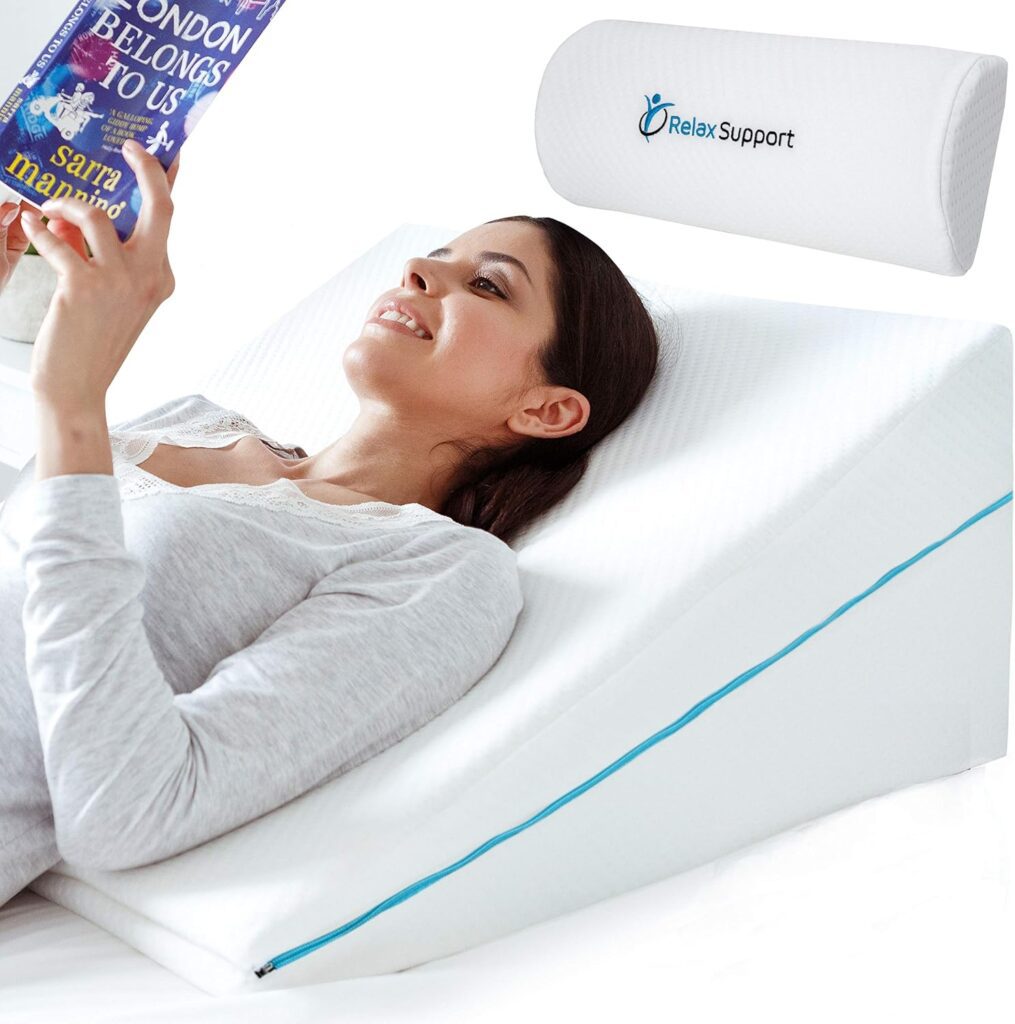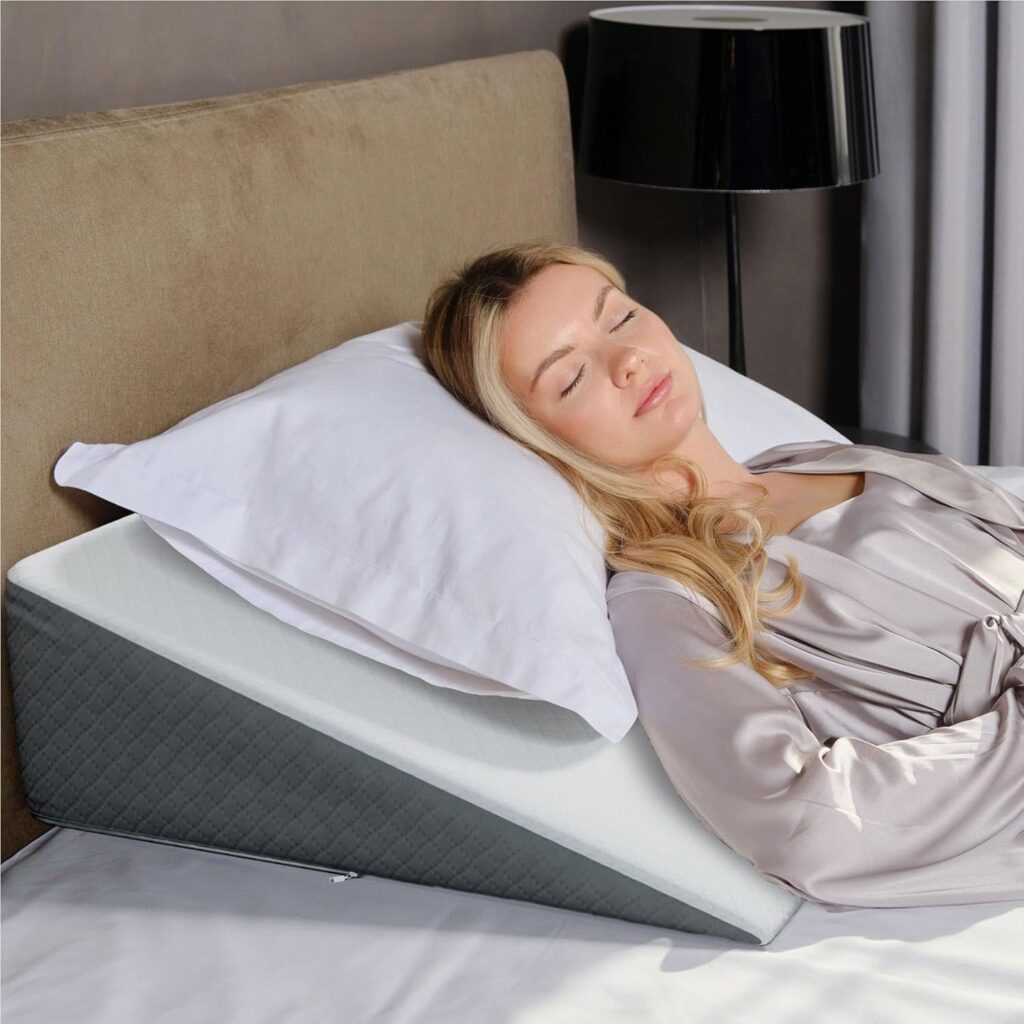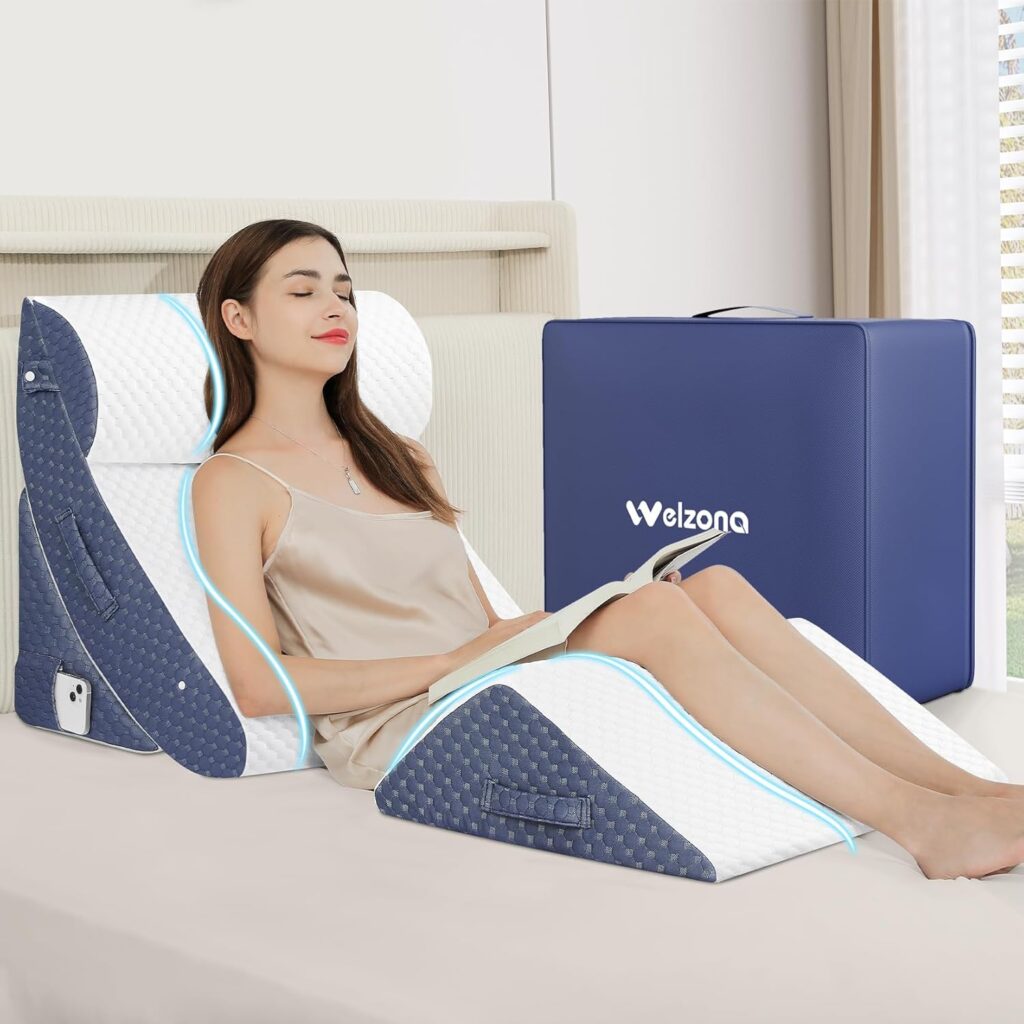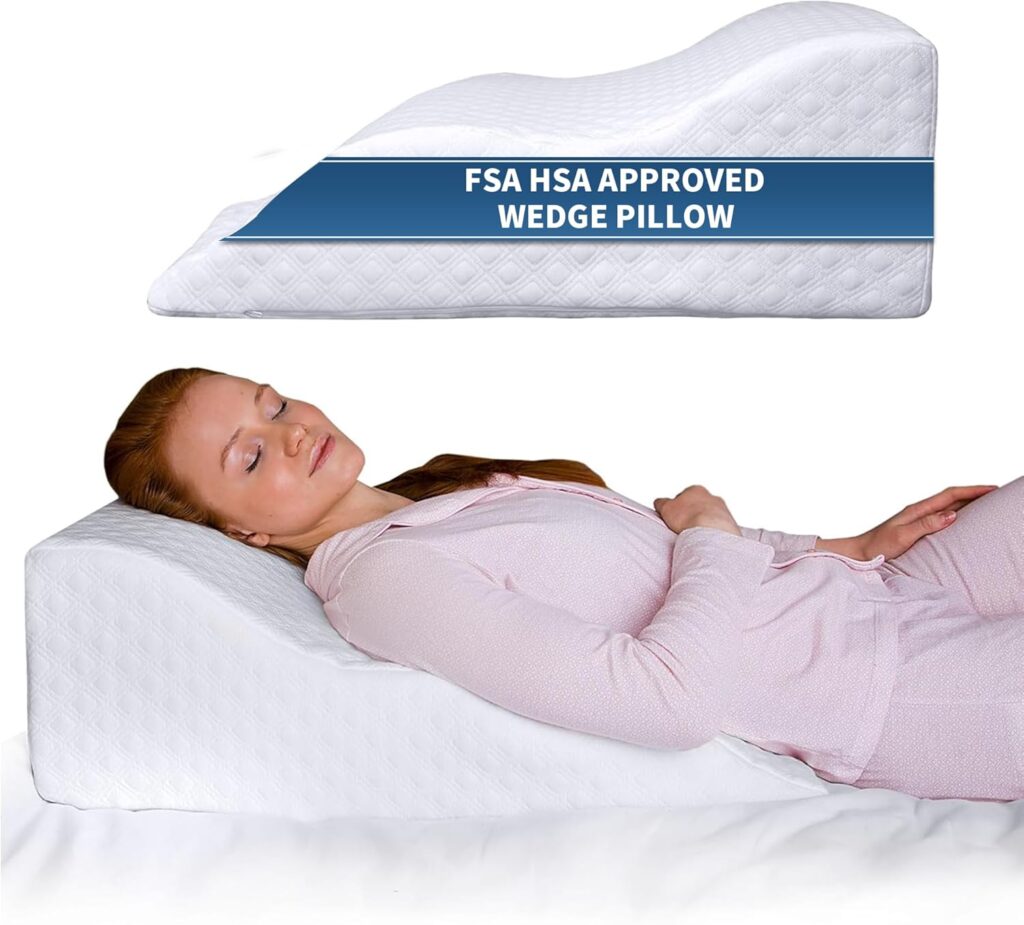5 Best Wedge Pillows for Sleep Apnea
If you’re struggling with sleep apnea, you know how it feels to wake up exhausted despite a full night in bed. Standard pillows often fail to provide the elevation needed to keep your airways open, leaving you with disrupted sleep, persistent fatigue, and worsening health concerns.
Wedge pillows are one of the most effective non-CPAP solutions, with clinical studies showing proper elevation may reduce sleep apnea symptoms by over 30%. After analyzing user reviews and expert recommendations, we’ve identified the five best wedge pillows designed to help you breathe easier, reduce snoring, and finally sleep better.
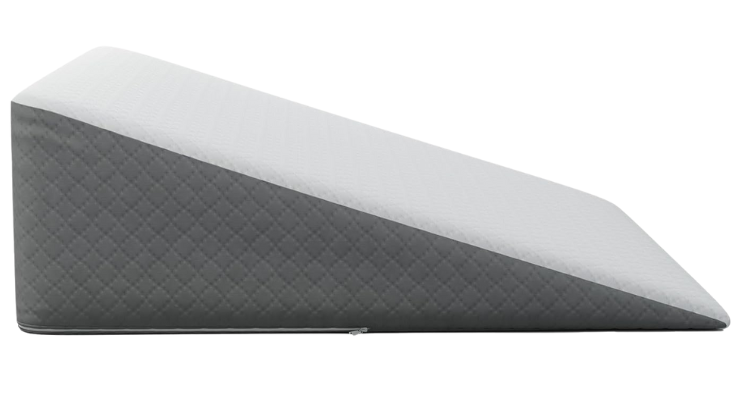
This article is for informational purposes only and not a substitute for medical advice. Consult a healthcare professional before adjusting your sleep setup for sleep apnea or other conditions. This post contains affiliate links. I may earn a small commission on qualifying purchases—at no extra cost to you.
Why Inclined Support Works for Sleep Apnea
Elevation cushions use gravity to your advantage. By raising your upper body, they prevent soft tissues in your throat from collapsing, helping to reduce airway blockages so that you can breathe easier and snore less. A 30–45-degree incline is often recommended for the best balance of relief and comfort.
An orthopedic bed wedge pillow not only improves breathing but can also reduce stomach acid reflux issues like GERD (gastroesophageal reflux disease) that often accompany sleep apnea. The proper elevation helps maintain pressure relief throughout your upper body while reducing pressure buildup in your airway. Here are our top five recommendations.
Top 5 Wedge Pillows for Sleep Apnea Relief
1. RELAX SUPPORT RS6 Memory Foam Wedge Pillow
Fill: 100% Memory Foam | Incline: 3 options (9°, 16.5°, or 25.5°) | Firmness: Medium-Firm
Sleep apnea sufferers will appreciate the RELAX SUPPORT RS6’s versatile 3-in-1 design.
Unlike basic wedges, this 100% memory foam pillow offers three elevation options: use the 4.5″ wedge for mild symptoms, the 7.5″ wedge for moderate relief, or combine both for maximum 12″ elevation.
Users praise its effectiveness for reducing snoring and improving breathing, with many noting better sleep quality after consistent use. The included half-moon bolster pillow provides additional neck or knee support, creating a complete sleep system.
Why It’s Ideal for Sleep Apnea Sufferers:
- Fully memory foam construction prevents compression that can reduce effectiveness
- Three separate elevation options to match symptom severity
- Wide 25″ design provides stable support without rolling off during sleep
- Compatible with CPAP machines while still maintaining comfort
For high-quality construction and adjustable elevation to suit your nightly needs, the RELAX SUPPORT RS6 provides outstanding comfort while supporting healthy, unobstructed breathing. Shop RELAX SUPPORT RS6 on Amazon here.
2. Kolbs Bed Wedge Pillow
Fill: Memory Foam Top Layer with Foam Base | Incline: 7.5 inches (Approximately 15°) | Firmness: Medium
Getting the right incline for sleep apnea can be tricky—too high and you’re uncomfortable, too low and it’s not effective.
The Kolbs Bed Wedge Pillow hits the sweet spot with its 7.5-inch height, the angle research shows can reduce apnea events by 30%.
Users consistently highlight its effectiveness for reducing snoring, with one noting their snoring had decreased significantly after just 3 days of use.
The luxurious jacquard cover provides better grip than slippery alternatives, reducing the common problem of sliding down during sleep.
Why It’s Ideal for Sleep Apnea Sufferers:
- Optimal 7.5″ height maintains open airways without neck strain
- Memory foam top layer provides comfort while the firm base ensures support
- Removable, machine-washable cover for easy maintenance
- Works well for both dedicated sleep apnea relief and general respiratory comfort
For those seeking a quality wedge pillow that effectively reduces snoring while remaining comfortable enough for nightly use, the Kolbs is highly recommended. Shop Kolbs on Amazon here.
3. AllSett Adjustable Bed Wedge
Fill: Memory Foam with Cooling Gel Layer | Incline: Adjustable (30° or 60°) | Firmness: Firm
The AllSett stands out among sleep apnea solutions for its 7-in-1 adjustable design, allowing you to find your perfect sleeping angle. Users with sleep apnea report significant improvement, sometimes within a couple days.
This versatile wedge features a the foldable memory foam design that can be positioned at both 30° and 60° angles. This flexibility is particularly valuable for sleep apnea sufferers who also deal with acid reflux, sinus congestion, or back pain, providing multiple therapeutic benefits in one product.
Why It’s Ideal for Sleep Apnea Sufferers:
- Adjustable angles let you find your optimal breathing position
- Memory foam provides pressure relief while maintaining proper elevation
- Cooling gel layer prevents overheating during sleep
- Portable design with carrying handle for consistent relief while traveling
Both post-surgery patients and those with chronic breathing issues praise this wedge for its comfortable support and durability. The versatile design makes it a smart investment for both short-term recovery and long-term sleep apnea management. Shop AllSett on Amazon here.
4. Welzona Orthopedic Wedge Pillow
Fill: Gel-Infused Memory Foam Top with High-Density Foam Base | Incline: 30° (Approximately 12 inches) | Firmness: Medium-Firm
The Welzona Orthopedic Wedge stands out for CPAP users battling sleep apnea. Many users praise its effectiveness for eliminating snoring completely, with significant improvements reported after just a few nights of use. Those transitioning from makeshift pillow arrangements to this purpose-built solution often note dramatic improvements in sleep quality and duration.
Perfect for back sleepers, this wedge maintains optimal airway positioning with its 12-inch height. The gel-infused memory foam layer offers cooling comfort while the dense base ensures you don’t sink down during the night, a crucial feature for maintaining consistent breathing support.
Why It’s Ideal for Sleep Apnea Sufferers:
- Firm enough for proper elevation without feeling hard or uncomfortable
- Wide support surface accommodates CPAP mask tubing without displacement
- Side pockets for convenient storage of small items like earplugs or mouth guards
- Includes machine-washable cover for easy maintenance
Many users mention this wedge as an excellent alternative to adjustable beds for managing breathing issues at a fraction of the cost. You can find it on Amazon here.
5. Aeris Memory Foam Wedge Pillow
Fill: Memory Foam | Incline: 8.5 inches with Ergonomic Curve | Firmness: Firm
The Aeris Wedge Pillow stands out for its unique curved design, making it ideal for side sleepers with sleep apnea.
Unlike standard wedges that force an awkward position for side sleepers, the Aeris features a specialized ergonomic curve that cradles your body while maintaining proper elevation.
Users with sleep apnea particularly appreciate how the curved shape conforms to their bodies, preventing the common problem of sliding down during sleep.
Many report significant reductions in snoring, with some noting the pillow has “eradicated” their snoring completely while improving overall sleep quality.
Why It’s Ideal for Sleep Apnea Sufferers:
- Unique curved design supports natural side-sleeping position
- Premium memory foam provides body-conforming support
- 8.5-inch height offers effective airway elevation
- Bamboo-blend cover enhances breathability and cooling
For side sleepers who have struggled with traditional flat wedges, this ergonomic design provides the elevation needed for sleep apnea relief while maintaining proper spinal alignment and comfort. Shop Aeris Memory Foam Wedge Pillow on Amazon here.
How to Choose Your Wedge Pillow for Sleep Apnea
Selecting the best elevation solution for sleep apnea doesn’t have to feel overwhelming. Focus on these key points to match your needs:
- Incline: Aim for 30–45 degrees if you need stronger relief; 7–12 inches works well if you’re new to wedges or prefer a gentle incline.
- Material: Memory foam offers reliable support—go for gel-infused if you tend to sleep warm, a common issue with sleep apnea.
- Size: Make sure it suits your body and bed size without taking over your space.
- Adjustability: Handy if you want to fine-tune the angle over time, especially as you adjust to elevated sleeping.
- Sleep Position: Side sleepers do best with a gentler slope, while back sleepers can handle a steeper incline. Stomach sleepers should look for specialized designs that accommodate chest and abdomen support.
Tip: Start with a lower angle and layer a thin pillow for extra softness if needed.
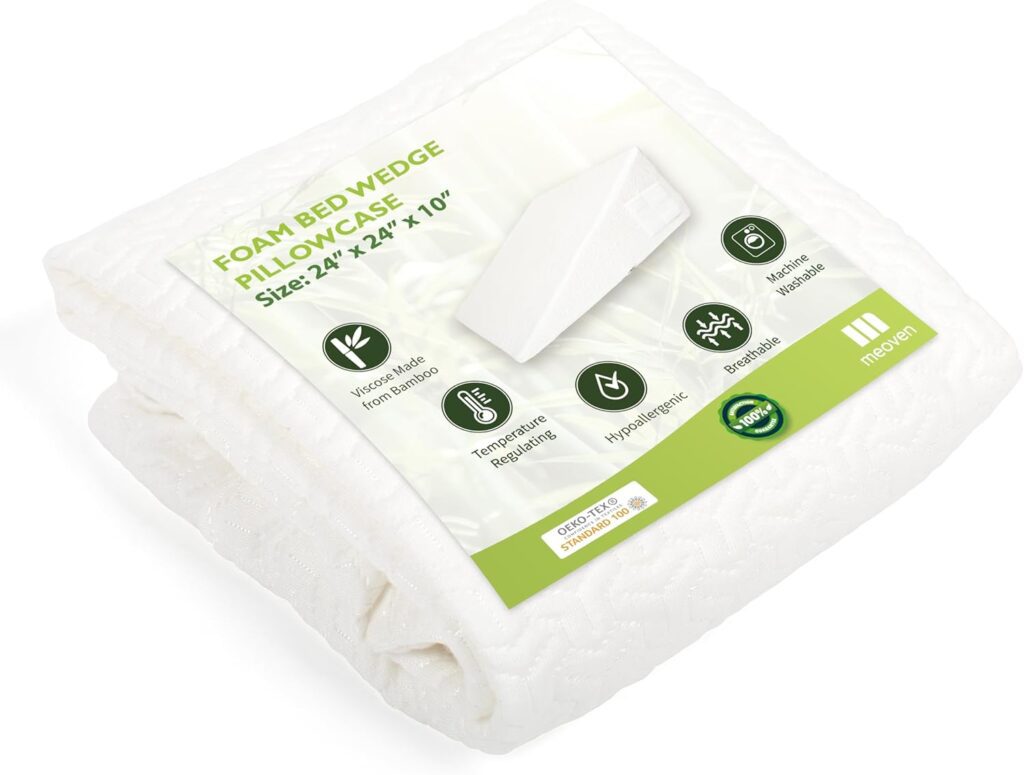
For easy upkeep, consider a removable cover like the MEOVEN Wedge Pillow Cover (fits 24x24x10 wedges), with hypoallergenic bamboo-derived fabric and handy pockets for your phone or remote. Alternatively if you prefer 100% Egyptian cotton, we recommend the Sleepnitez Bed Wedge Pillow Cover.
Tips to Get the Most From Your Wedge Pillow
- Ease In: Begin with a slight incline to get used to it.
- Set It Up Right: High end at the headboard, shoulders on the slope.
- Stay Comfortable: Use breathable bedding or cooling foam if you run warm.
- Give It Time: Stick with it for a week to notice the difference.
Additional tips: If it shifts, tuck it under your mattress. If it feels too hot, look for gel options.
Adapt Your Sleep Apnea Support for Different Sleep Positions
While elevated sleeping helps many sleep apnea sufferers, each sleeping position requires specific considerations:
For Back Sleepers
Most wedge pillows work well since this position naturally aligns with the incline. You’ll experience maximum airway opening and reduced pressure on your diaphragm.
For Side Sleepers
Look for wedges with a gentler slope or curved design. The Aeris model is particularly good for maintaining proper spinal alignment while side sleeping.
For Stomach Sleepers
Traditional wisdom suggests avoiding stomach sleeping with sleep apnea, but if you can’t break the habit, consider a very low-angle wedge (under 15°) and place a thin pillow under your hips to reduce spinal curve.
The Neutral Position Advantage
Regardless of your preferred position, a properly selected wedge helps maintain your spine in neutral alignment, reducing both sleep apnea symptoms and morning pain.
Avoid These Common Pitfalls for Better Sleep Apnea Relief
Using an inclined sleep support for sleep apnea can work wonders, but a few common hiccups might trip you up. Here’s how to sidestep them for a smoother experience:
Sliding Down the Slope
It’s frustrating to wake up slumped at the bottom of your elevation cushion. To keep your sleep apnea support in place, tuck it snugly under your mattress or use a non-slip mattress pad. Some options, like those with textured bases, grip better naturally—check for that feature when shopping.
Neck Discomfort
Switching to an inclined sleep position can sometimes leave your neck feeling off. Pick a support with the right height for your frame—too steep can strain you. Adding a small neck pillow can also ease the transition, keeping your head aligned without extra fuss.
Disturbing Your Partner
If your bedmate notices every shift, a bulky sleep aid might not help. Choose an elevation option sized for your side of the bed—many are compact enough to avoid overlap. For full customization, a split adjustable bed frame lets you both sleep your way without compromise.
Feeling Too Warm
Heat can undo the relief an inclined support offers, especially if sleep apnea already has you restless. Look for options with cooling gel foam or breathable designs—common in top picks like those above. Pair it with moisture-wicking sheets and pajamas to stay comfortable all night.
How to Maintain Your Wedge Pillow for Lasting Sleep Apnea Relief
Proper maintenance keeps your elevation cushion working effectively for your sleep apnea, ensuring it stays comfortable and supportive for years to come. Here’s how to care for it correctly:
Keep It Clean for Better Sleep
Most wedge pillows for sleep apnea come with removable, washable covers—perfect for staying fresh if you sweat or use a CPAP. Wash the cover every 1–2 weeks following the manufacturer’s instructions. Most covers are washing machine safe, but always check the label. For the cushion itself, spot clean with mild detergent and let it air dry fully to avoid mold or odors.
Choose Quality Pillow Material
Invest in high-quality memory foam or gel-infused options that will retain their shape over time. Premium pillow material not only lasts longer but provides more consistent pressure relief throughout its lifespan.
Rotate and Flip for Even Wear
High-quality foam can settle over time, especially with nightly use. Rotate your sleep support 180 degrees every few weeks to distribute wear evenly. If it’s double-sided, flip it occasionally too—this simple step extends its life and keeps support consistent.
Refresh with Sunlight (Sparingly)
A quick sun session can zap odors and revive your sleep support’s foam—a bonus for sleep apnea sufferers sensitive to stuffiness. Limit exposure to 20–30 minutes to avoid UV damage, keeping your cushion in top shape for better rest.
Combining Wedge Pillows with Other Sleep Apnea Treatments for Maximum Relief
An inclined sleep solution can be a powerful tool for sleep apnea relief, but it shines brightest as part of a broader plan. Here’s how to pair it with other strategies:
Positional Therapy for Side Sleepers
If your sleep apnea worsens on your back, team your wedge pillow with a positional therapy device to encourage side sleeping. Understanding the best sleeping positions for your condition can help you maximize relief. This combo can work wonders for position-dependent cases, helping you breathe easier all night.
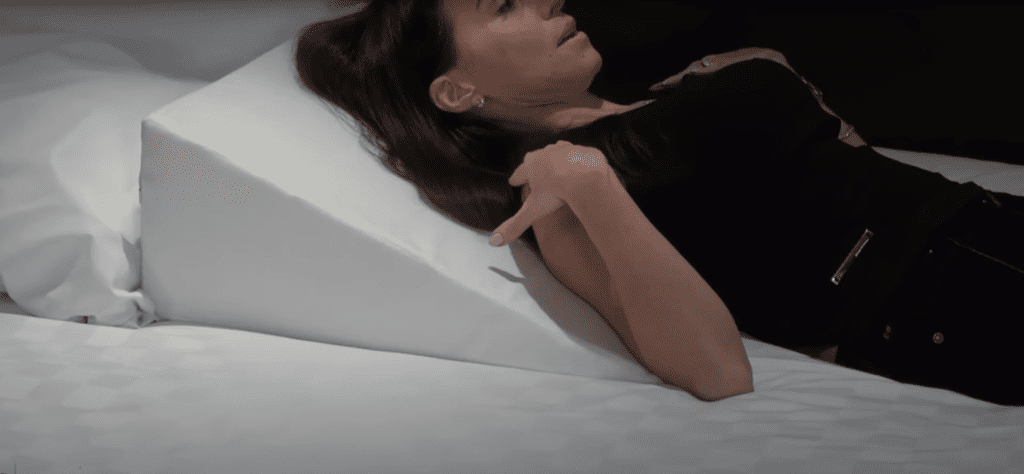
Lifestyle Tweaks to Boost Benefits
Pairing your sleep apnea wedge pillow with lifestyle changes can amplify its impact. Establishing a healthy sleep routine alongside these changes can further improve your results. Try these if they fit your situation:
- Shedding extra weight to reduce airway pressure.
- Skipping alcohol before bed to keep breathing steady.
- Sticking to a regular sleep schedule for consistency.
- Quitting smoking to improve lung health.
- Managing GERD and stomach acid issues with dietary changes
Small steps like these, alongside your wedge, can make a big difference.
Controlling Health Factors
Sleep apnea often occurs alongside other health conditions. An orthopedic bed wedge pillow can help manage related issues like:
- Elevated blood pressure which often improves with better sleep quality
- Acid reflux and GERD symptoms that decrease with proper elevation
- Nasal congestion that lessens when gravity works in your favor
Always consult with a healthcare professional with any health concerns.
Oral Appliances for Added Support
For some, a mandibular advancement device plus an inclined sleep solution offers better symptom relief than either alone. It’s a solid option if your sleep apnea needs extra help—check with your specialist to see if it’s right for you.
The Psychology of Adjusting to a Wedge Pillow for Sleep Apnea
Switching to an inclined sleep position for sleep apnea isn’t just physical—it’s a mental shift too. Here’s how to ease into it with confidence:
Stay Positive About the Change
A good mindset helps you adapt to your new sleep posture. Focus on the payoff—better breathing, less snoring, more energy. This mental boost can smooth out those first few nights on your elevation support.
Relax Into Your New Routine
Feeling uneasy about the incline? Use relaxation tricks like progressive muscle relaxation or guided imagery as you settle in. These calm your mind, easing any tension and helping your sleep apnea relief kick in.
Stick With It for Results
Consistency is key with a sleep apnea elevation solution—even if it feels odd at first. Use it every night to let your body and brain adjust faster. A week or two in, it’ll start feeling like second nature.
Tracking Your Wedge Pillow’s Impact on Sleep Apnea
Wondering if your new sleep support is helping your sleep apnea? Monitoring your progress gives you clear answers—here’s how:
Start a Sleep Diary
Keep a simple sleep diary for two weeks before and after using your wedge pillow. Jot down:
- How long it takes to fall asleep.
- How often you wake up at night.
- Morning signs like headaches or dry mouth.
- Daytime tiredness levels.
This log shows how your sleep apnea symptoms shift with the wedge.
Use Sleep Apps for Data
A sleep tracking app or device can dig deeper into your patterns—think snoring frequency or sleep stages. It’s an easy way to see if your sleep support for sleep apnea is cutting disruptions and increasing quality sleep time.
Check In With Your Doctor
After a few weeks with your wedge, book a follow-up with your sleep specialist. They’ll review your diary or app data and tweak your plan if needed, ensuring you’re getting the best sleep apnea relief possible. They can help interpret your progress and make any necessary adjustments to your treatment plan.
Customizing Your Wedge Pillow Setup for Sleep Apnea Comfort
Every sleep apnea sufferer’s needs are different. Tailor your wedge pillow setup with these tips for the best fit:
Add Toppers for Extra Comfort
Fine-tune your wedge with pillow toppers—memory foam for softness, latex for bounce, or wool for breathability. Experiment to find the perfect balance of support and coziness for your sleep apnea needs.
Adjust Your Bed Position
For even more relief, slightly raise your bed frame’s head with risers alongside your wedge pillow. This gentler incline can enhance breathing without feeling too steep—a subtle tweak with big benefits.
Pair With Support Pillows
Strategize with extra pillows: a small one under your lower back eases strain, while a body pillow keeps side sleepers aligned. These additions make your sleep apnea support setup work harder for you.
How Elevation Can Transform Sleep Apnea Management
Finding the best inclined sleep solution for sleep apnea can transform your nights—and your days. Whether you’re battling restless sleep solo or pairing it with CPAP therapy, options like RELAX SUPPORT with its full memory foam construction or Kolbs with its research-backed 7.5-inch height offer reliable elevation.
For side sleepers, Aeris provides ergonomic comfort with its curved design, while AllSett’s versatile angles accommodate different sleeping positions and needs. The benefits of elevated sleeping—better breathing, less snoring, more energy—are within reach when you choose the right design for your sleep style and needs.
Remember to give yourself time to adjust to elevated sleeping, and always coordinate with your sleep specialist when adding an inclined sleep solution to your sleep apnea management plan. Those with mild sleep apnea may find a gentle incline provides sufficient relief during sleep.
Frequently Asked Questions
What is the best pillow to use for sleep apnea?
The best pillow for sleep apnea depends on your specific needs and sleeping position.
Wedge pillows like the RELAX SUPPORT RS6 and Kolbs Bed Wedge are excellent for back sleepers, as they elevate the upper body to help keep airways open. For side sleepers with sleep apnea, the Aeris Memory Foam Wedge with its curved design provides proper support while maintaining side-sleeping alignment.
CPAP users often benefit from specially designed pillows with cutouts for mask tubing, but a properly positioned wedge like the Welzona Orthopedic Wedge can also accommodate mask wear while providing the elevation needed to improve breathing.
How high should a wedge pillow be for sleep apnea?
For sleep apnea relief, the ideal wedge pillow height depends on the severity of your symptoms and comfort preferences. Generally, a wedge with a 7-12 inch elevation (approximately 15-30 degrees) works well for most people.
Research shows that even a 7.5-degree incline can reduce apnea events by up to 30%. Those with more severe symptoms may benefit from steeper inclines of 30-45 degrees.
If you’re new to wedge pillows, starting with a gentle incline like the Kolbs 7.5-inch model allows you to adjust gradually, while adjustable options like the AllSett let you experiment with different heights to find your optimal position.
How do I choose the right wedge pillow?
To choose the right wedge pillow for sleep apnea, consider these key factors:
- Sleeping position: Side sleepers need curved or gentler slopes (like the Aeris), while back sleepers can use steeper inclines.
- Incline height: Start with 7-12 inches if you’re new to wedge pillows, or consider adjustable models like the AllSett.
- Material quality: Look for memory foam or gel-infused foam that maintains shape while conforming to your body.
- Cover material: Choose breathable, washable fabrics like bamboo blends that help regulate temperature.
- Size: Ensure the pillow is wide enough for comfortable movement and fits your bed size.
- Additional health concerns: If you have acid reflux or GERD along with sleep apnea, you may benefit from steeper inclines.
- CPAP compatibility: If you use a CPAP machine, choose a wedge with sufficient width and stability to accommodate your mask and tubing.
Starting with a medium-firm option allows you to add a softer topper if needed while maintaining proper support.
Can a wedge pillow replace CPAP therapy?
While wedge pillows can be effective for mild to moderate sleep apnea, they typically cannot replace CPAP therapy for severe cases. Always talk to your doctor before making changes to your sleep apnea treatment plan.
What type of pillow is best for sleep apnea?
The best pillow for sleep apnea is one that provides proper neck and head support to maintain an open airway during sleep. A wedge pillow or an adjustable contour pillow is often recommended, as these can elevate the upper body or position the head to help reduce snoring and improve airflow.
Specifically designed CPAP pillows, which are contoured to accommodate CPAP masks, can also be beneficial for those using CPAP therapy. It’s important to choose a pillow that promotes proper alignment, comfort, and minimizes pressure on the neck to help alleviate sleep apnea symptoms.
How long does it take to get used to sleeping on a wedge pillow?
Most people adjust to sleeping on a wedge pillow within 1-2 weeks. However, some may adapt more quickly, while others might need up to a month to feel fully comfortable.
Are wedge pillows good for side sleepers with sleep apnea?
Yes, many wedge pillows can be effective for side sleepers. Look for models specifically designed for side sleeping or use additional pillows for support.
Can wedge pillows help with snoring?
Wedge pillows can often help reduce snoring by keeping the airways more open. However, if snoring persists, it’s important to consult a doctor to rule out underlying sleep apnea.
How often should I replace my wedge pillow?
The lifespan of a wedge pillow depends on it’s quality and usage. Generally, high-quality wedge pillows should be replaced every 2-3 years, or sooner if you notice a decrease in support or comfort.
Is it bad to sleep with a wedge pillow all night?
No, it’s not bad to sleep with a wedge pillow all night, as long as it supports your body properly and maintains good alignment. In fact, wedge pillows can provide relief for conditions like sleep apnea, acid reflux, and back pain by helping to elevate your upper body and reduce pressure.
However, it’s important to ensure that the pillow is comfortable and doesn’t cause discomfort or strain over time. If you’re using it regularly, consider checking with a healthcare professional to ensure it’s the right solution for your specific needs.
Do wedge pillows work for all types of sleep apnea?
Wedge pillows are most effective for obstructive sleep apnea (OSA). They may be less useful for central sleep apnea or complex sleep apnea syndrome.
Always talk to a sleep specialist for personalized advice.
Can wedge pillows cause neck pain?
Improperly sized or positioned wedge pillows can cause neck pain. Start with a lower incline and gradually increase to find the right angle. Ensure your neck is properly supported to prevent strain.
What are the disadvantages of wedge pillows?
Wedge pillows can sometimes slide down during sleep, leaving you unsupported, though tucking them under your mattress helps. They might cause neck discomfort if the height’s off—adding a small pillow can fix that. Overheating is another issue, but choosing cooling foam or breathable bedding keeps you comfortable.
Key Takeaways
- Tracking your progress and consulting with your doctor can help improve your sleep apnea management plan.
- Inclined sleep solutions can significantly improve sleep quality for people with sleep apnea by elevating the upper body.
- Look for supports with the right angle, high-quality materials, and suitable size for your needs.
- Proper positioning and gradual adaptation are crucial for success with elevated sleeping.
- Combine inclined sleep supports with other sleep apnea management techniques for best results.
- Don’t be afraid to experiment with different options and techniques to find what works best for you.
- Regular maintenance and proper care can extend the life and effectiveness of your sleep support.

